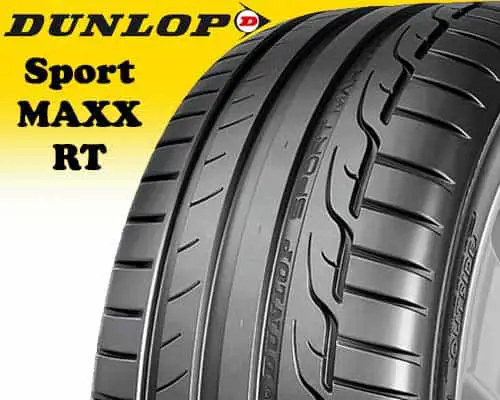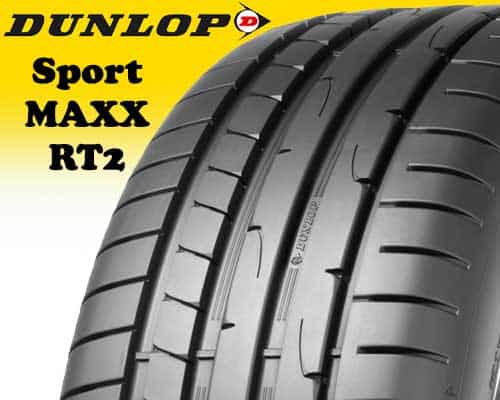Both tires are max performance summer tires and were compared under the same tire size of 225/40 R18. Here, RT is the predecessor of RT2 and these tires comprise similar technologies with the exception of differences in their tread designs.
RT2’s design gives it a far better grip not only on dry roads but also wet roads, while RT has a reliable ability to sustain a confident grip on dry surfaces. Find out more about their unique designs in the upcoming sections that make one stand out more than the other in different territories.

Table of Contents
Comparison of the Dunlop Sport Maxx RT with RT2

Vs

The Dunlop Sport Maxx RT has an asymmetrical tread design with three deep and relatively wide circumferential grooves and one dashed line groove. This tire has enough surface area to maintain an amazing grip on dry roads. Its traction on wet roads is also exceptional, owing to its deep grooves and sipes that help it against aquaplaning and supports it to stand its ground during rainy seasons. Moreover, because of the prominent sipes on its shoulders, it has superior handling on wet roads and due to its more optimized shoulders, it has amazing handling on dry roads as well.
On the other hand, RT2 also features a very similar asymmetrical tread pattern to RT, which isn’t surprising, as it is the successor of RT. It has better traction on wet surfaces than its predecessor because of its increased void ratio with four narrow circumferential grooves and more sipes. Moreover, it has a considerable footprint just like its forerunner that works wonders to provide a good grip in dry conditions. It has smaller incisions but they are present in a substantial amount on its shoulders which makes its handling better on wet surfaces but reduces it on dry roads. All and all, it has more satisfying wet traction than its competitor. Therefore, it is better suited for wet climates.
Road Grip Comparison
RT features dense tread design with very few siping. It takes 37.4 secs to stop on dry roads from 100 km/h, which is a little longer than its competitor.
In comparison, RT2 has a similar symmetrical tread design and just about a little more surface area in contact with the road than its adversary. It can stop from 100 to 0 Km/h in just 36.2 secs. Both of the tires come at toe with each other in this territory but RT2 has an upper hand by a little margin.
Handling Comparison of the tires
The shoulder of the tire is the prime determinant of handing on the road. RT contains more prominent siping on its shoulders but are available in fewer amounts. Due to this, it has a large surface area on its shoulder that significantly increases its dry handling, with a lap time of only 50.1 secs on the dry handling course section. Its handling on wet roads is good but not as good as the RT2, because of the smaller void ratio in the shoulder, it has a lap time of 68.5 secs on the wet course.
RT2 has prominent siping on its shoulders. Thus, it has better handling and cornering on wet roads with the help of its eminent sipes that wipe away water while cornering and turning, making its lap time just 63.3 secs on the handling course section. Meanwhile, these incisions decrease its aptitude on dry roads, reducing its grip while turning which makes its lap time longer (69.7 secs). Therefore, RT2 has superior handling on wet roads and RT has greater handling on dry surfaces.
Comparison of Hydroplaning Resistance
A tire that has better water evacuating ability has greater chances of avoiding hydroplaning and holds better wet traction. RT features three continuous grooves and one dashed line groove that runs along the length of the tire. These grooves can accommodate a decent amount of water to effectively avoid hydroplaning and move confidently on wet roads. Nevertheless, it includes minor siping on its tread blocks with no siping on the central rib that reduces its traction by not effectively relocating water away from the treads. This tire fails to beat extreme wet conditions as its self-cleaning ability is not sufficient to forcibly wipe away large sums of water. Thus, it still performs worse than the RT2 in these extreme conditions owing to its smaller void ratio. It also stops at a longer distance than the RT2 in damp conditions, making its wet braking inferior with 57.1 meters of stopping distance from 100 km/h. Moreover, it has a float speed of 72.8 km/h, making it less desirable on wet surfaces as well.
Conversely, RT2 consists of four narrow circumferential grooves and much more prominent siping on its tread blocks. Therefore, RT2 has a higher capacity to capture water in its channels and has a superior ability to wipe away the water by a large number of sipes. This makes RT2 less prone to aquaplaning than the RT, especially when the conditions are intense. It sopped in just 48.7 meters from 100 km/h on wet roads, making its wet breaking better than the RT. Furthermore, the float speed of this tire is 73.3 km/h, also making it better to drive on wet roads.
Rolling Resistance
RT has a relatively better surface area in its tread design with the addition of broken groove channels on one side of the tire that also increases its surface area. This results in higher rolling resistance and makes it difficult to roll with a rolling resistance of 8.79 kg/t. Hence, spending more energy in the process. This makes the tire less efficient and economical.
In contrast, RT2 has a comparatively open tread design than RT, with a higher void ratio. This reduces the surfaces area of the tire and decreases its rolling resistance, making it just 8.50 kg/t. Since it requires minimal power to spin on the road, its tread wear characteristics are significantly improved. Therefore, RT2 has a better tread-wear than RT.
Moreover, since both tires have the same roots, they also possess identical features to some extent. Firstly, they are both fabricated from a dual silica compound that not only makes them flexible to sit well on the road but also promotes lower rolling resistance and therefore lower wear and tear of the tires. Secondly, both of them contain joistless belts (JLB) in their internal structure. It is a hybrid overlay technology that supports the tire at high speeds and stimulates even wear. Last but not the least, Maximum Flange Shield (MFS), It protects the rims from curb damage. All of these features make these tires quite exceptional.
Comfort and Noise Comparison
The RT2 contains a coarse tread design with larger grooves that can potentially capture air in the treads of the tire. This air collides back and forth to produce vibrations and a louder noise which makes it less comfortable on the road with a noise level of 71 dB.
While the RT has a dense tread pattern with comparatively smaller grooves in its treads that capture less air and therefore generate fewer vibrations and it has a noise level of just 69.1 dB. This makes RT slightly more comfortable than RT2 in comparison.
Furthermore, Dunlop’s Noise Shield Technology is embedded in both of the tires, this technology comprises an adhering layer of soundproof foam in the inner structure of the tires to reduce their noise levels.
Quick Summary
- Both of the tires are max performance summer tires.
- Dry Braking in both tires is almost the same, but RT2 performs a little bit better.
- RT2 has a better ability to sustain its grip on wet surfaces than the RT by the virtue of a considerable number of siping.
- RT2 has better handling on wet roads while the RT has better handling on dry roads
- The Tread-wear of RT2 is somewhat better than the RT due to lower rolling resistance.
- The Comfort level of RT2 is better than RT with lower noise levels.